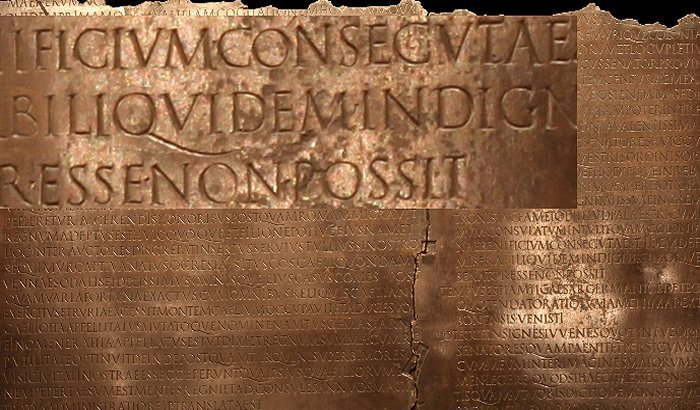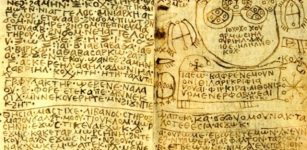Roman Square Capitals: Prestigious Script That Delighted Human Eye With Its Elegance
A. Sutherland - AncientPages.com - We have been using this cultural achievement of the ancient Romans for at least 2,500 years.
Roman square capitals (also called capitalis monumentalis, or capitalis quadrata), are an ancient Roman form of writing and the basis for modern capital letters.
 The 5th-century Vergilius Romanus work. Source
The 5th-century Vergilius Romanus work. Source
The earliest Roman script was entirely in capitals, and in all eras, this form of writing delighted the human eye with its elegance.
To this day, the Roman square capitals can be admired on old stone inscriptions. Before the 4th century, square capitals were used to write de luxe copies of the works. The only three surviving manuscripts using this letter, among them the ‘Vergilius Augustus’, contains works by Virgil.
They look like printed today, and yet they required immensely more work than inserting a card into the printer and merely pressing ‘enter,’ as we do today.
This script – not only elegant but also beautiful – was believed to be exclusively reserved for valuable manuscripts and used for the most important and revered works such as Virgil or the Holy Bible.
Square capitals were indeed very difficult to write because of their straight lines and right angles.
The scribe was undoubtedly a skilled person. He had to plan the inscription on a given surface, drew auxiliary lines, like in a school notebook, then sketched the outline of letters, and then forged them with a chisel.
The work required high precision; the material did not tolerate errors. This writing was much more suited for carving inscriptions on the stone using a chisel. It was not recommended for a text written on parchment or papyrus with a pen.
Roman square capitals are also called "Elegant Capitals" and represent an ancient Roman form of writing, and the introduction for our modern capital letters. Used in manuscripts and inscriptions, the Roman capitals were often written without breaks between words, or with words separated by dots.
 Roman square capitals on the Arch of Titus, c. AD 81. Source
Roman square capitals on the Arch of Titus, c. AD 81. Source
The font of the formal Roman script was based on typography, in which most letters could be written in a square. Square capitals had sharp, straight lines; the angles were also used but only the right ones.
This form of writing was undoubtedly exquisite and is found in the city of Rome on inscriptions that decorate Trajan's Column, the Arch of Titus, and the Roman Pantheon all in Rome.
However, after the 5th century, the square capitals fell out of use and became less frequent; the script was stiff and very slow to write. The Romans used a current cursive hand known as Latin cursive for everyday writing, as we know it very well, today.
The ancient Roman script was based on a modified Greek alphabet.
 The Lyon Tablet, a bronze tablet from after AD 48. Source
The Lyon Tablet, a bronze tablet from after AD 48. Source
According to Roman legend, the Cimmerian Sibyl, Carmenta, adapted the Greek alphabet used in the Greek colony of Cumae in southern Italy, to create the Latin alphabet. The legend says that this alphabet was introduced to Latium by Evander, her son, and it took place sixty years after the Trojan War.
Officially, the Latin, (or Roman alphabet) was adapted from the Etruscan alphabet during the 7th century BC to create Latin. Since then, it had different forms, and was adapted to form many languages.
At the time of the splendor of the Roman Empire, the Latin alphabet had 23 letters. Initially, there was no letter 'W,' which was added later in the Middle Ages, and derived from two letters 'V' placed next to each other.
During the Renaissance ((14th–17th centuries), the letter 'J' began with the letter 'I,' and the letter 'U' with the letter 'V' began to budge. The introduction of lowercase letters, based on the Greek alphabet, improved the readability and speed of rewriting texts.
The most popular computer font, ‘Times New Roman’ is a derivative of the square capital. It was created in 1929 at the request of the British newspaper Times. The font was designed by Stanley Morison from Monotype. Because the newspaper publisher used the printing machinery of a competitor, Linotype, Monotype had to license it.
Linotype began advertising the font as 'Times Roman'. The font itself, though modeled on classic Roman writing, is narrower, adapted to the narrow columns of the newspaper.
Written by - A. Sutherland - AncientPages.com Senior Staff Writer
Copyright © AncientPages.com All rights reserved. This material may not be published, broadcast, rewritten or redistributed in whole or part without the express written permission of AncientPages.com
Expand for referencesReferences:
Avrin L. Scribes, Script, and Books: The Book Arts from Antiquity to the Renaissance
More From Ancient Pages
-
 On This Day In History: John Dee, English Mathematician, Occultist, Astrologer, Astronomer Was Born – On July 13, 1527
News | Jul 13, 2016
On This Day In History: John Dee, English Mathematician, Occultist, Astrologer, Astronomer Was Born – On July 13, 1527
News | Jul 13, 2016 -
 3,000-Year-Old City Of Sillyon That Alexander The Great Failed To Conquer
Archaeology | Aug 31, 2020
3,000-Year-Old City Of Sillyon That Alexander The Great Failed To Conquer
Archaeology | Aug 31, 2020 -
 Castor And Pollux: Dioscuri Brothers Immortalized In The Night Sky In Greek Beliefs
Featured Stories | Jan 24, 2024
Castor And Pollux: Dioscuri Brothers Immortalized In The Night Sky In Greek Beliefs
Featured Stories | Jan 24, 2024 -
 Underground Hellenistic Necropolis With Tombs With Frescoes, Reliefs Unearthed In Naples, Italy
Archaeology | May 13, 2023
Underground Hellenistic Necropolis With Tombs With Frescoes, Reliefs Unearthed In Naples, Italy
Archaeology | May 13, 2023 -
 On This Day In History: Battle Of Fraustadt – One Of The Most One-Sided Swedish Victories – On Feb 3, 1706
News | Feb 3, 2017
On This Day In History: Battle Of Fraustadt – One Of The Most One-Sided Swedish Victories – On Feb 3, 1706
News | Feb 3, 2017 -
 On This Day In History: Casanova – Famous Seducer And Adventurer Dies In A Castle In Bohemia – On June 4, 1798
News | Jun 4, 2016
On This Day In History: Casanova – Famous Seducer And Adventurer Dies In A Castle In Bohemia – On June 4, 1798
News | Jun 4, 2016 -
 Megalithic Cemetery With 49-50M Long Tombs Was Accidentally Found In Poland
Archaeology | Mar 10, 2021
Megalithic Cemetery With 49-50M Long Tombs Was Accidentally Found In Poland
Archaeology | Mar 10, 2021 -
 A 2,700-Year-Old Urartians’ Ayanis Castle And Haldi Temple – Soon An Open-Air Museum
Archaeology | Aug 10, 2020
A 2,700-Year-Old Urartians’ Ayanis Castle And Haldi Temple – Soon An Open-Air Museum
Archaeology | Aug 10, 2020 -
 Almost 3,000 Year-Old Burial Site Of Urartian Royals Discovered In Turkey’s Famous Van
Archaeology | Jul 31, 2019
Almost 3,000 Year-Old Burial Site Of Urartian Royals Discovered In Turkey’s Famous Van
Archaeology | Jul 31, 2019 -
 Puzzling Comb Drawing In Huenul Cave May Be The Oldest Rock Art In South America
Archaeology | Feb 15, 2024
Puzzling Comb Drawing In Huenul Cave May Be The Oldest Rock Art In South America
Archaeology | Feb 15, 2024 -
 Unclear Purpose Of Mysterious Rock-Cut City Of Petra – Was It A Fortress Or Sacred City?
Featured Stories | May 30, 2020
Unclear Purpose Of Mysterious Rock-Cut City Of Petra – Was It A Fortress Or Sacred City?
Featured Stories | May 30, 2020 -
 Prehistoric Swiss Army Knife Shows How Early humans Communicated
Archaeology | Jun 9, 2022
Prehistoric Swiss Army Knife Shows How Early humans Communicated
Archaeology | Jun 9, 2022 -
 Unearthing Vadnagar And The Search For Hueng Tsang’s 10 Monasteries
Archaeology | Dec 11, 2015
Unearthing Vadnagar And The Search For Hueng Tsang’s 10 Monasteries
Archaeology | Dec 11, 2015 -
 Nippur – Holy City Of God Enlil And One Of The Oldest Cities Of Sumer
Featured Stories | Jul 24, 2023
Nippur – Holy City Of God Enlil And One Of The Oldest Cities Of Sumer
Featured Stories | Jul 24, 2023 -
 Ancient Mystery Of Baktiotha And The Egyptian Spell Book
Artifacts | Sep 4, 2015
Ancient Mystery Of Baktiotha And The Egyptian Spell Book
Artifacts | Sep 4, 2015 -
 Discovery Of Chromosomes Offers Evidence Of Ancient Humans Living In South America Over 18,000 Years Ago
Archaeology | Aug 21, 2022
Discovery Of Chromosomes Offers Evidence Of Ancient Humans Living In South America Over 18,000 Years Ago
Archaeology | Aug 21, 2022 -
 Enigmatic Denisovans Interbred With Modern Humans More Than Once
Archaeology | Mar 22, 2018
Enigmatic Denisovans Interbred With Modern Humans More Than Once
Archaeology | Mar 22, 2018 -
 Massive Well-Preserved Second Temple-Era Aqueduct Unearthed In Jerusalem
Archaeology | Aug 29, 2023
Massive Well-Preserved Second Temple-Era Aqueduct Unearthed In Jerusalem
Archaeology | Aug 29, 2023 -
 Enigmatic Human Fossil Jawbone May Be Evidence Of An Early Homo Sapiens Presence In Europe
Evolution | May 2, 2023
Enigmatic Human Fossil Jawbone May Be Evidence Of An Early Homo Sapiens Presence In Europe
Evolution | May 2, 2023 -
 Rare Minoan Sealstone Is A Miniature Masterpiece Unearthed In 3,500-Year-Old Tomb Of Powerful Mycenaean Warrior
Archaeology | Nov 8, 2017
Rare Minoan Sealstone Is A Miniature Masterpiece Unearthed In 3,500-Year-Old Tomb Of Powerful Mycenaean Warrior
Archaeology | Nov 8, 2017
